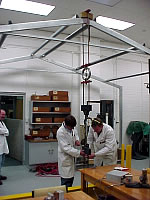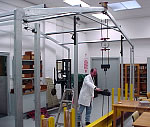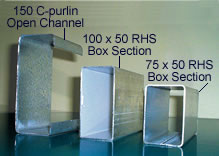Report on load tests on portal frames for Statewide Constructions
Introduction
A series of three frames were load tested. The purpose of the tests was to undertake a comparative assessment of the in-plane strength of the three frame types.
- Frame No 1 consisted of 100x50 RHS column and rafter members, with tie bar across the ridge
- Frame No 2 consisted of 75x50 RHS column and rafter members, with tie bar across the ridge
- Frame No 3 consisted of 150 C-purlin column and rafter members, no tie bar
Attachment 1 contains load-deflection results for the 100x50 RHS frame. This test provides load deflection values up to the first point of failure. Failure occurred as a result of one connection on the crosstie bar giving way. It is probable that a stronger tie connection would have permitted a higher load to be obtained. The measured failure load was 110kN or approximately 1.1 tonnes. The maximum central deflection was about 50mm.
Attachment 2 contains load-deflection results for the 100x50 frame reloaded from zero after the failure of the crosstie connection. This test provides load-deflection values for the untied frame up to the limit of the load application device (turnbuckle). The turnbuckle ran out of travel at 140mm deflection at the central ridge, and while the frame underwent massive deflection, no apparent failure of any section was observed. At this load it was observed that the connections at the ridge and the eaves were suffering substantial distortion and local distress, but column and rafter sections were not seen to be yielding. The load achieved before stopping the test was 9.2 kN. It can be observed from the plots that the load was approaching the load limit of the frame.
Attachment 3 contains load-deflection results for the 75x50 RHS frame. The frame underwent a central ridge deflection of 97mm before failure occurred in the rafter adjacent to the tie connection. This was an in-plane failure with no apparent flexural-torsional buckling effects. The maximum load achieved at failure was 10.0 kN. Note that this is approximately the same as the larger frame, although this is coincidental, owing to the different mode of failure.
Attachment 4 contains load-deflection results for the C-purlin frame. The frame demonstrated substantial flexural-torsional (lateral) buckling effects at ultimate load. The ultimate load was 5.5 kN, approximately half that of the two previous frames. The frame was braced for lateral effects identically with that of the two previous frames. Maximum central deflection was 86 mm at ultimate load. Deflection plots, unlike those for previous frames, exhibited very high degrees of non-linearity immediately prior to failure. The failure can be deemed to have occurred at the connections due to buckling of the connection brackets.



